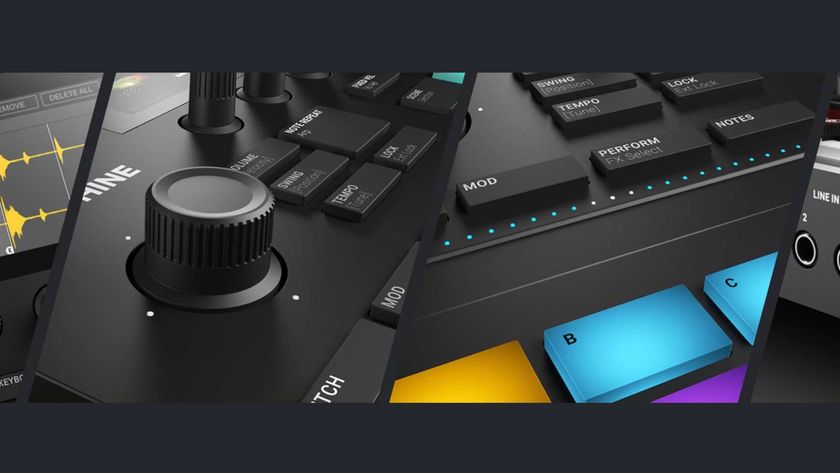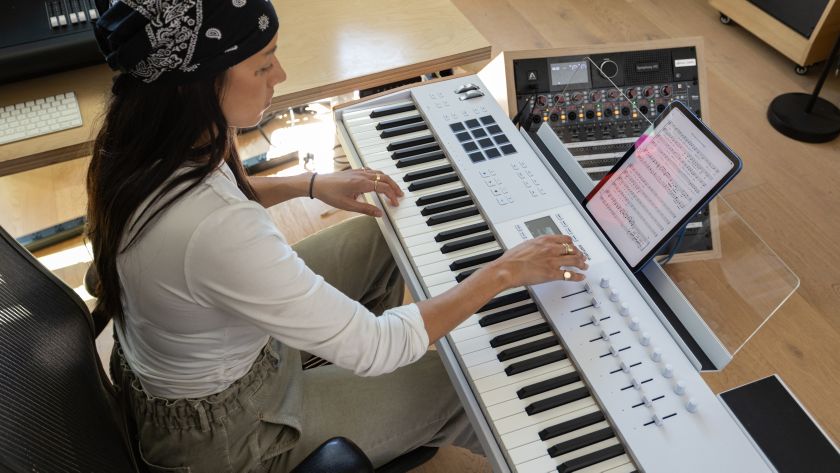Roland launches A-88 and A-49 MIDI controller keyboards
Portable and piano-sized models announced

Roland A-88

Roland A-49
Roland has announced a couple of new MIDI keyboards: the A-49 and A-88. While these are part of the same range, each model is designed to appeal to a very different kind of user.
The 4-octave A-49 is lightweight and portable, but also designed to be rugged enough to gig with. The full-size A-88, meanwhile, has the hammer-action keys that will attract piano-playing computer musicians.
Both models sport a D-Beam controller, user-assignable knobs and switches, and Octave and Transpose buttons. The A-88 also has Dual/Split, Upper, and Lower buttons for splitting and layering tones.
Owners of Roland's SuperNatural-powered synths can also make use of some additional control options by hitting the SuperNatural button.
You can read more on the A-49 and A-88 - both of which will work with the iPad via the Camera Connection Kit - below.
Roland A-49 and A-88 press release
Roland is pleased to announce the A-88 and A-49 MIDI Keyboard Controllers, two all-new controllers that combine pro playability with mobile convenience. The piano-action A-88 and synth-action A-49 feature high-quality keyboards along with a slim, light design ideal suited for on-the-go musicians. They also offer USB, MIDI, and Apple iPad compatibility, as well as onboard control of Roland's SuperNATURAL-powered synths such as the INTEGRA-7, JUPITER-80, and JUPITER-50.
There's no shortage of keyboard controllers on the market, but most have playability that's far below the quality found in high-end digital pianos and synthesizers. The A-88 and A-49 offer keyboard controllers that play like pro-level instruments, giving musicians' mobile convenience with no compromises. From the bedroom studio to the big stage, these controllers truly deliver inspiring playability and top-level performance.
Get the MusicRadar Newsletter
Want all the hottest music and gear news, reviews, deals, features and more, direct to your inbox? Sign up here.
The A-88 features 88 full-size weighted keys built around Roland's acclaimed Ivory Feel-G Keyboard with Escapement. This is the same Progressive Hammer Action keyboard found in many Roland stage and home pianos, and allows users to play software-based pianos, soft-synths, and sound modules with an authentic grand piano touch. In addition, the white keys are built with a moisture-absorbing material that replicates the feel of real ivory. Even with its premium hammer-action keyboard, the A-88 is light, portable, and easy for gigging musicians to transport.
Born for mobile use, the A-49 features road-tough construction yet is extremely lightweight, coming in at under six pounds. The 49 full-size velocity-sensitive keys have a rounded shape for a comfortable touch, along with many enhancements to reduce noise and increase playability, resulting in a premium keyboard that even the most discerning pros will appreciate.
Both the A-88 and A-49 include many performance features, including a pitch bend/mod lever, D-BEAM controller, user-assignable knobs and switches, and OCTAVE and TRANSPOSE buttons. The A-88 also has DUAL/SPLIT, UPPER, and LOWER buttons for splitting and layering tones on its full-size keyboard.
The dedicated SuperNATURAL mode button on the controllers unlocks a host of unique sound-selection features when connected to a Roland SuperNATURAL instrument such as the new INTEGRA-7 sound module or the JUPITER-80 and JUPITER-50 synths.
The A-88 and A-49 offer USB and MIDI OUT connectors, along with jacks for connecting optional expression and hold pedals. Both controllers can be powered via a computer's USB bus, while the A-88 can also be powered with an accessory AC adapter. Additionally, the A-49 and A-88 work with PC and Mac operating systems (including iOS music apps on the iPad via Apple iPad Camera Connection Kit). SONAR X1 LE DAW is bundled with both controllers, giving Windows users a ready-to-go music production environment.
The A-88 and A-49 come standard in a handsome black finish. The A-49 is also available in white, a perfect companion colour for users of the white-finish iPad.
For more information, visit www.RolandConnect.com.

I’m the Deputy Editor of MusicRadar, having worked on the site since its launch in 2007. I previously spent eight years working on our sister magazine, Computer Music. I’ve been playing the piano, gigging in bands and failing to finish tracks at home for more than 30 years, 24 of which I’ve also spent writing about music and the ever-changing technology used to make it.





![Chris Hayes [left] wears a purple checked shirt and plays his 1957 Stratocaster in the studio; Michael J. Fox tears it up onstage as Marty McFly in the 1985 blockbuster Back To The Future.](https://cdn.mos.cms.futurecdn.net/nWZUSbFAwA6EqQdruLmXXh-840-80.jpg)






